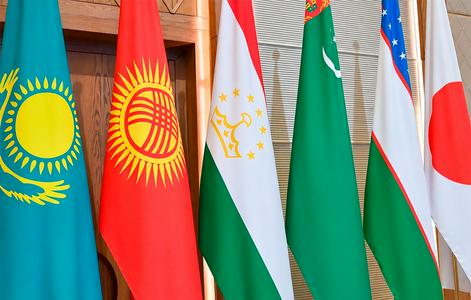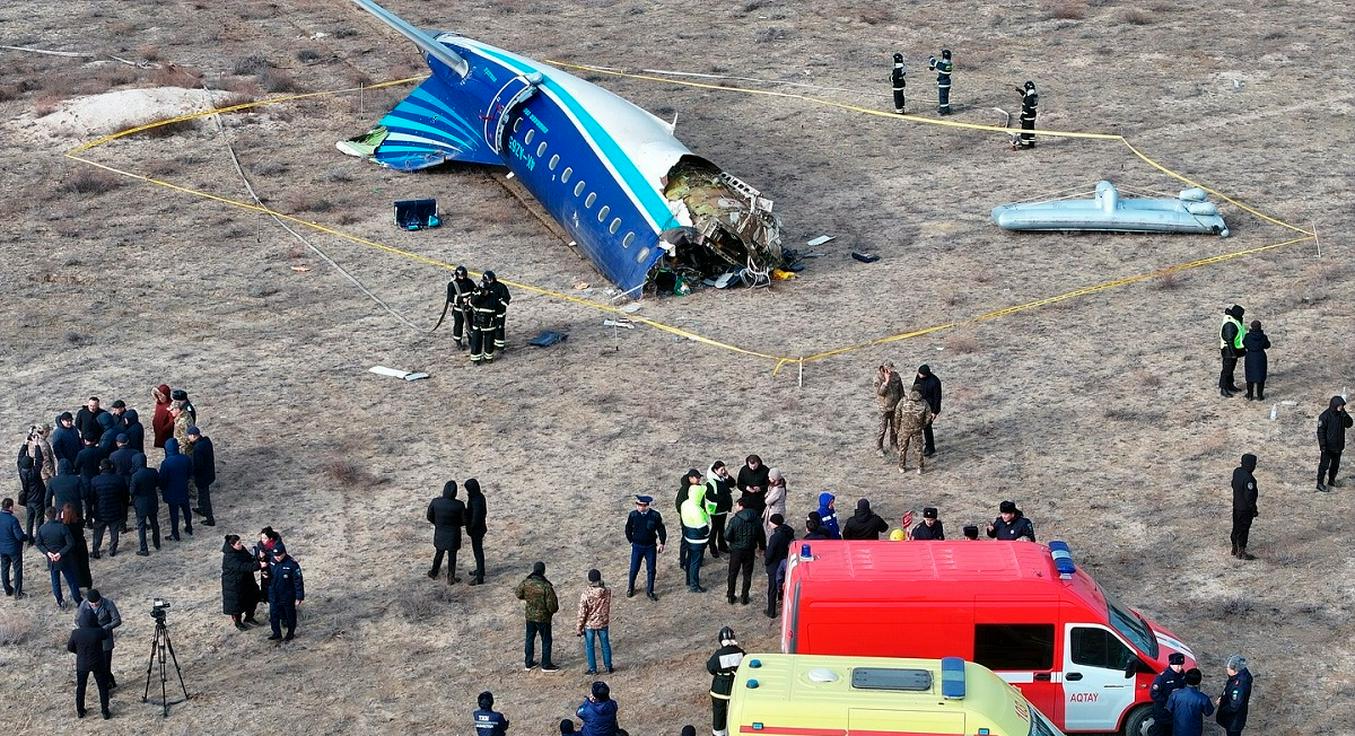At Kazakhstan’s Aktau airport — a city perched on the shores of the Caspian Sea—a passenger plane en route from Azerbaijan to Russia crashed, leaving a scene of devastation in its wake. The aircraft went down in a field adjacent to the runway, breaking into several pieces before catching fire. Some passengers—primarily those seated in the rear—managed to survive. The cause of the disaster remains a mystery, with investigators facing the daunting task of uncovering what led to the crash. Even experts are grappling with more questions than answers at this point. Here is what we know so far, as reported by Fergana.
At 6:56 a.m. Moscow time on December 25, an Embraer E190 aircraft operated by Azerbaijan Airlines, bearing tail number 4K-AZ65, took off from the Azerbaijani capital of Baku en route to the Russian city of Grozny. The journey was expected to be brief—just over an hour. However, the aircraft was unable to land at its destination due to adverse weather conditions. According to Alvi Shakhgiriyev, general director of Grozny Airport, the Embraer attempted to land three times but was thwarted by dense fog and low clouds. Faced with these conditions, the pilot opted to divert to an alternate airport.
“He informed our air traffic controllers that he was heading back to Baku,” Shakhgiriyev told reporters. “Later, he changed course and set out for Aktau.” The flight, Shakhgiriyev noted, appeared to proceed without incident, and the captain did not report any technical problems.
On the same day, Grozny came under attack from Ukrainian drones, all of which were intercepted and destroyed. Some media outlets speculated that this military activity might have prevented the plane from landing. Shakhgiriyev dismissed these claims. “The aircraft left our airspace before the implementation of the ‘Kover’ plan,” he said in an interview with the Regnum news agency, referring to the contingency protocol activated in response to drone attacks.
One of the survivors, Subkhonqul Rakhimov, later recounted the three failed attempts to land in Grozny. “From what I counted, he tried to land twice. The third time, something exploded,” Rakhimov told Russia Today. “There was an explosion—I wouldn’t say it was inside the plane. Where I was sitting, the paneling nearby came off.”
According to Rakhimov, he reached for a life vest only to discover it had been punctured by shrapnel. “I grabbed the vest, and I saw: there was a hole in it—it had been pierced by a shard,” he said. “That explosion—right between my legs, somewhere around there—that’s where the shard flew in and hit. It went straight through the vest,” he told the broadcaster.
After the unsuccessful landing attempts, the pilots diverted the plane toward Kazakhstan. Before the crash, the aircraft flew erratically over the Caspian Sea, with significant fluctuations in altitude and speed. Passenger footage captured during the flight shows oxygen masks dangling from the cabin ceiling and severe damage to the fairing on the left wing.
At 8:35 a.m. Moscow time, the crew issued a distress signal, reporting a failure in the flight control system. By 9:02 a.m., the aircraft had entered Kazakh airspace, requesting an emergency landing in Aktau. The crew attempted to land the plane using direct mode—a manual control system bypassing autopilot. Communication with the aircraft was lost at 9:28 a.m., and nine minutes later, at 9:37 a.m., it crashed. According to Talgat Lastayev, Kazakhstan’s Deputy Minister of Transport, the plane made two circuits near Aktau Airport and crashed on the third approach. The aircraft’s black box has been recovered and will be submitted as evidence in the criminal investigation.
Kazakhstan's law enforcement authorities will lead the probe into the crash’s causes. According to ORDA.kz, citing sources within the investigation, both Azerbaijan and Russia—whose citizens were among the passengers—requested official roles in the investigative commission but were denied. They will be permitted to participate only as observers.
“Thus, all the facts, the black box, and the evidence will remain under our jurisdiction,” a commission member told the outlet.
Several theories regarding the crash have been put forward so far. The first suggests a bird strike, as reported by Artem Korenyako, spokesperson for the Russian Federal Air Transport Agency (Rosaviatsiya). “Preliminary findings indicate that following a bird strike, an emergency situation developed on board the aircraft, prompting the commander to divert to an alternate airfield—Aktau was selected,” Korenyako wrote on his Telegram channel.
Azerbaijan Airlines also cited the possibility of a collision with a flock of birds shortly after the incident, according to the Russian news agency TASS. However, aviation expert Serik Mukhtybayev pointed out a significant flaw in this hypothesis: it is highly improbable for birds to simultaneously damage both engines, and even with one engine disabled, the flight could have continued. Furthermore, the crew reported technical issues about an hour into the flight—by then, the aircraft would have reached a considerable altitude where bird strikes are less likely.
A second theory speculates that after a bird strike, a cylinder on board exploded. This claim was mentioned by the Mangistau Region’s Health Department and some eyewitnesses. However, experts have expressed skepticism. “There are no gas cylinders on board an aircraft. At most, there might be an oxygen cylinder in the first-aid kit for resuscitation purposes. What other cylinders could be on board is unclear. Fire extinguishers don’t explode. And an oxygen cylinder would only detonate under extreme conditions, like being thrown into a fire,” Roman Gusarov, editor of the Avia.ru portal, told Vzglyad.
According to a source in the emergency services who spoke to Interfax, the crew reported a failure of «one of the main systems» to air traffic control prior to the crash, though they did not specify which system was involved. The source also noted that the version involving a technical malfunction is currently being considered a priority.
The Embraer E190AR that crashed had been in service for 11 years. Azerbaijan Airlines stated that the aircraft underwent a full technical inspection very recently, on October 18, 2024.
Finally, another version of the crash's cause emerged after photos and videos were published showing multiple small, through-and-through holes in the fuselage of the aircraft, resembling damage from projectiles. However, Kazakhstan’s Deputy Prime Minister, Kanat Bozumbaev, who is leading the commission investigating the incident, firmly advised against making conclusions about the origins of these holes before the investigation is completed.
«I must not make premature statements. Even preliminary causes are impossible to establish at this stage: there are specialists who will conduct the necessary work and expertise,» he emphasized.
There were 67 people on board the crashed aircraft—62 passengers and five crew members. Of these, 38 died and 29 survived. All the injured are in the hospital. Among the survivors were nine Russians, out of a total of 16 aboard, as reported by RBC. Also among the passengers were six Kazakh citizens, all of whom are listed among the deceased published by the country’s Ministry of Emergency Situations. These include Sandibek Tulesinov, born in 1988; Bauyrzhan Dzhumagulov, born in 1985; Galina Makhudova, born in 1978 (all three lived in Mangistau region); 49-year-old notary Gaukhar Shaymerdenova, with her 11-year-old son Eldar Zhumagatov, and 29-year-old Salima Zhutaeva.
Also aboard were 37 citizens of Azerbaijan, 23 of whom perished, and three citizens of Kyrgyzstan— all three of whom survived.
The bodies of the deceased Azerbaijanis will be sent home in the coming days. A separate flight for the injured will be organized as soon as their transportation is allowed. Due to the plane crash, Azerbaijani President Ilham Aliyev cut short his visit to Russia, where he was supposed to participate in an informal CIS summit, and returned to Baku.
December 26 has been declared a day of mourning in Azerbaijan.
-
 24 December24.12To Clean Up and to ZIYAWhat China Can Offer Central Asia in the “Green” Economy
24 December24.12To Clean Up and to ZIYAWhat China Can Offer Central Asia in the “Green” Economy -
 23 December23.12PhotoTokyo DriveJapan to invest about $20 billion in projects across Central Asia over five years
23 December23.12PhotoTokyo DriveJapan to invest about $20 billion in projects across Central Asia over five years -
 17 December17.12Sake for SixCentral Asia’s Rapprochement with Japan Comes with Hidden Pitfalls
17 December17.12Sake for SixCentral Asia’s Rapprochement with Japan Comes with Hidden Pitfalls -
 17 December17.12Gulshan Is the BestYoung Uzbek Karateka Becomes World Champion
17 December17.12Gulshan Is the BestYoung Uzbek Karateka Becomes World Champion -
 24 November24.11Here’s a New TurnRussian Scientists Revive the Plan to Irrigate Central Asia Using Siberian Rivers
24 November24.11Here’s a New TurnRussian Scientists Revive the Plan to Irrigate Central Asia Using Siberian Rivers -
 11 November11.11To Live Despite All HardshipUzbek filmmaker Rashid Malikov on his new film, a medieval threat, and the wages of filmmakers
11 November11.11To Live Despite All HardshipUzbek filmmaker Rashid Malikov on his new film, a medieval threat, and the wages of filmmakers





